In which historical period was the greatest image of the Prophet (PBUH) created + images
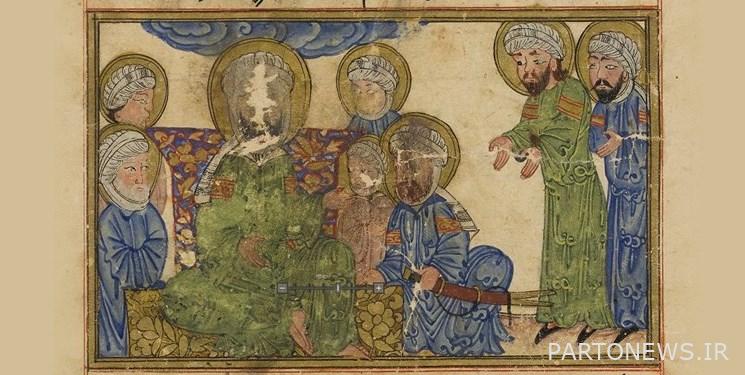
According to the visual correspondent of Fars News Agency, in the history of Iranian painting, the period of Mongol rule in the eighth lunar century has been considered as a period of transition or formation. In other words, in this era, the classical style of painting emerged, as at the beginning of this period, Tabriz is known as the capital of the Ilkhanids, the most important center of painting. Studies show that various religious images and historical events of the life of the Holy Prophet (PBUH) have been depicted in manuscripts and illustrations of the patriarchal era. The depiction of the image of the Prophet (PBUH) in expressing the important events of his life can be clearly seen in the illustrated and famous versions of this era. In the meantime, the pictorial elements of the icon have been used to distinguish and emphasize the spiritual position of the Prophet (PBUH) in the parliament of this period.
In the Timurid era, a suitable arena for artistic and cultural fertility was formed. Herat school in this era, went through a very fruitful period, which is part of the important works of this school. But another part of the activity of Herat Teymouri school belongs to the second half of the ninth lunar century.
The strong belief of the Timurid sultans and princes and their rulers in the Sufi elders made the ninth century one of the favorable periods for the spread of Sufism and the growing influence of Sufism. This approach, along with the Timurid policy of supporting significant cultural activities, was closely related to the political leanings and position of the Timurid rulers. The Timurid rulers sought to gain cultural prestige through cultural support, especially by supporting the literary activities of art and culture, which are themselves signs of power. One of these activities is paying attention to the iconography of religious subjects, including the image of the Messenger of God, which was considered in both Shiraz and Herat Teymouri schools.
After the Timurids, the Safavids ruled Iran for more than two centuries, leaving thousands of examples of painting techniques. The strong belief in the family of the Prophet and their strong prejudices brought about new developments in the iconography of the Messenger of God, especially in the scene of the Ascension. The religious beliefs of the Safavids during Shiite sectarianism led to a large part of ritual iconography with a more popular taste in Ascension parliamentarism and among the works of Shiite art. It seems that the mask with which the face of the Messenger of God was covered was incorporated in the Safavid era and during the severe prejudices of their religious beliefs, because when depicting some other illustrated copies, the face of the Messenger of God was clearly displayed. The Safavid era is the end of the middle history of Iran.
* The beginning of iconography of the Prophet (PBUH) in the Seljuk period
According to the available documents, the Seljuk era (Konya school) is the beginning of the iconography of the Prophet (PBUH). These icons are very simple, with little attention and attention to detail, rough and oblique limbs. What is important in this period, in addition to a simple statement in depicting the Prophet and giving importance to the overall staging and narration of the story, is drawing the face of the Prophet (PBUH) from the opposite angle, which is probably rooted in Buddhist art.
The Prophet next to the graves of two lovers, the Seljuk era, Vargheh and Golshah
One of the special features of this school is the lack of sanctity of the halo around the head, which is commonly used for all figures, especially Arab figures, and in addition to its decorative aspect, has played an important role in separating the statue from the background.
Other features of Seljuk iconography include short figures with large heads, a narrow strip on the arm or dress, the use of flat colors without shading, closed and dynamic atmosphere, and two-dimensional drawings in which the image of the Prophet (PBUH) is in the background, and a structure that It is a combination of straight and sometimes curved lines, emphasizing the position of the icon, he noted.
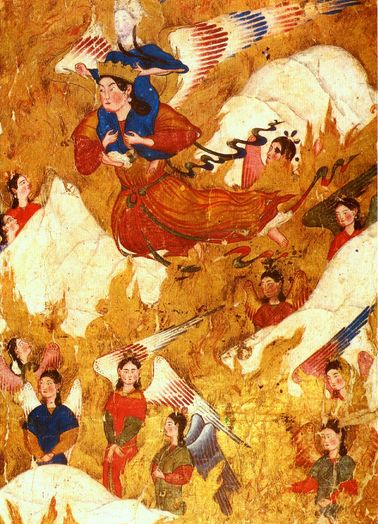
Ascension of the Prophet (PBUH), patriarchal era, ascension letter
* Adding a halo around the head in the patriarchal era
Iconography of the patriarchal era (Tabriz school) has more developments. The abundance of illustrations of the Messenger of God, especially in the manuscripts of the historical community, has shown the freedom of the artist to act in the iconography of the Messenger of God.
During this period, the stature of the figures became taller and the size of the head and the size of the limbs were reduced. Gold, like the Seljuk period, has been common behind all those present in the painting.
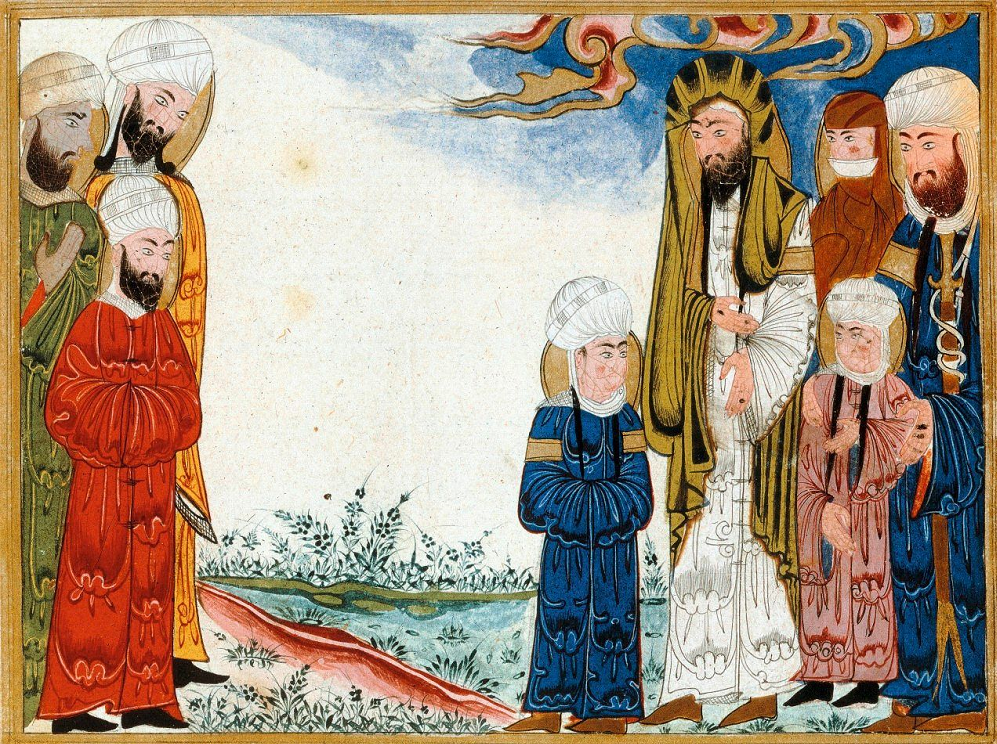
Mubahila, Al-Baqiyya Biruni, 707 AH (Ilkhanid era – Tabriz school)
In the icons of Tabriz school, the colors are flat and without shading, but the variety of colors in this period is more than the Seljuk period. The emphasis of the geometric structure of the paintings of this period is also on the position and location of the image of the Prophet.
* Timurid period and the green color of the Prophet’s clothes (PBUH)
The Timurid era (Herat and Shiraz schools) is significantly different from previous periods. The Prophet, with a fiery halo behind his head and a mask on his face, is completely different from the others, and like the painting of the patriarchal era, the body is taller and more fit.
Unlike the Seljuk period and like the Ilkhanid period, the bodies are drawn completely flat and vertical. The connection of the icons with the architectural space is very prolific and has various geometric patterns and the interior space is obvious.

Ascension of the Prophet (PBUH), Timurid era, Sultan Mohammad Noor
In the paintings of this period, space dominates the form of the icon; In other words, the icon forms a small part of the vast space of the image.
In this era, the type of cover is still as simple and uniform as in the Seljuk period. The color of the Prophet’s clothes is generally green and it seems that this color was specific to him.
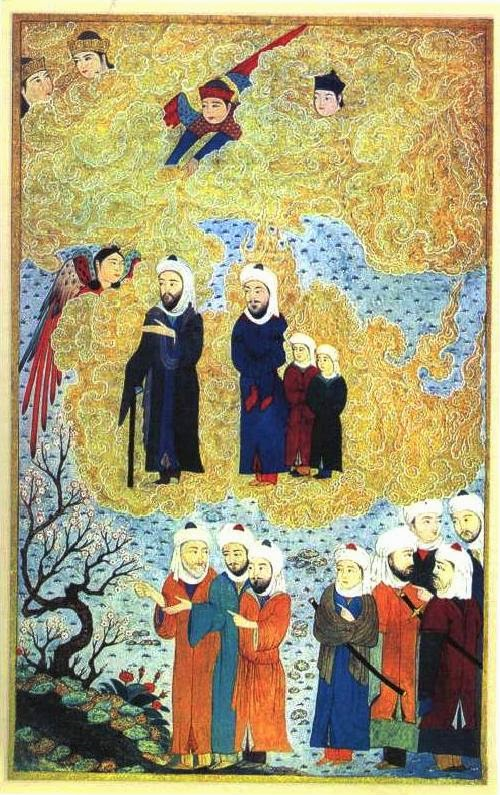
The Prophet with 12 Imams on the Day of Resurrection, Timurid Age, Anthology of Alexander
The coloring is still flat and without shading, with finer engraving than in the past, and the compositions remain asymmetrical, static, and vibrant. The geometric structure of the drawings is based on curved lines and emphasizes the position of the Prophet (PBUH).
* Safavid, the peak of the iconography of the Prophet (PBUH)
The Safavid era (Tabriz and Shiraz schools) is the peak of prosperity in dealing with the image of the Prophet (PBUH). Among the iconographic features of this era, tall statues with well-proportioned heads and the fiery form of the flames behind the icon are much taller and have more branches than in the Timurid period. The iconography of this period is completely different from previous eras due to the form of fire on the back of the head, the mask on the face, the shawl around the neck and the elegance and various motifs on the garment.
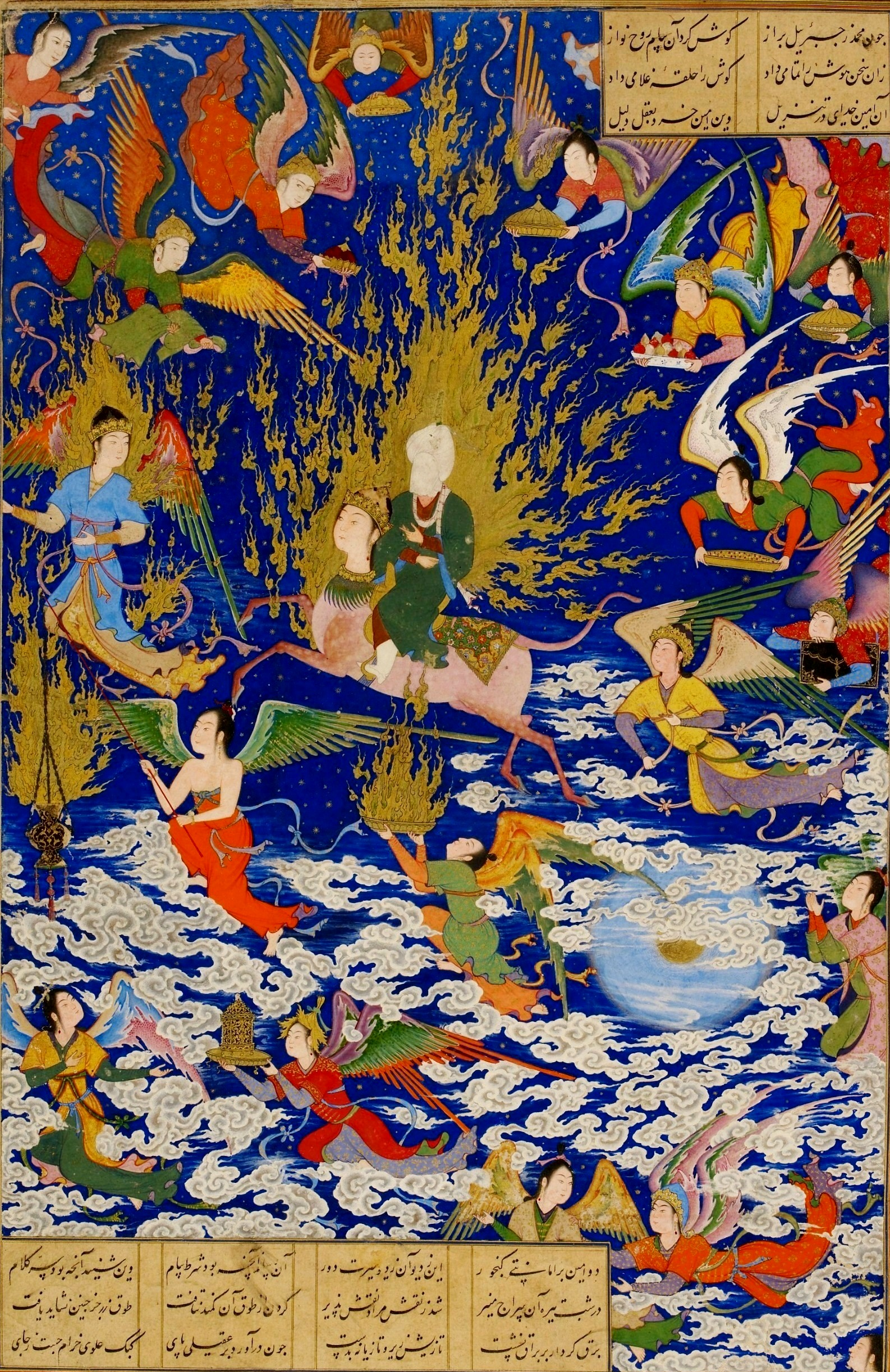
Ascension of the Prophet, Safavid era, military body week
The paintings are still composed of three or four plans and have a uniform coloring without shadows and very delicate engraving and the creation of patterned spaces. In this period, unlike the Timurid period, we see the superiority of the icon over the painting environment; The color of the Prophet’s clothes, which was green during the Timurid period, has also been observed in some Safavid paintings. In the Timurid and Safavid eras, they have common features in structure, which are: spiral and circular compositions, which have been done for the concept of the spiritual movement of the icon towards the right and balance in the work, through symmetry.
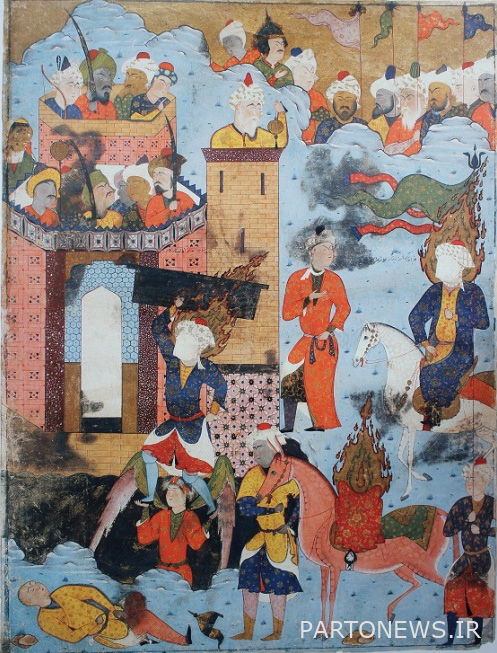
Prophet and Imam Ali in the conquest of Khyber, Safavid period, fortune telling
The most prominent feature of the chromatography of these icons is the use of cold and warm colors, dark and light, harmony and color harmony, which the painter has used in emphasizing the position of the Prophet (PBUH). With the end of the Middle Ages in Iran, the skill in the iconography of the Messenger of God gradually faded and flourished.
End of message /
.

